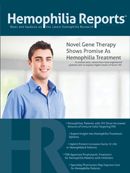Publication
Article
Hemophilia Reports
2011: A Breakthrough Year in HCV Treatment
The medical community welcomed two new direct-acting antiviral (DAA) agents for HCV-telaprevir (Incivek, Vertex Pharmaceuticals Incorporated) and boceprevir (Victrelis, Merck & Co., Inc.)-with an excitement that hadn't been seen since 1990.

In 2011, the medical community welcomed two new direct-acting antiviral (DAA) agents for HCV—telaprevir (Incivek, Vertex Pharmaceuticals Incorporated) and boceprevir (Victrelis, Merck & Co., Inc.)—with an excitement that hadn’t been seen since 1990.
Before 1990, HCV was generally considered incurable, and use of early interferons helped only 10% of chronic HCV patients. In 1990, when new pegylated interferons (peg-IFNs) were combined with an antiretroviral agent, ribavirin, cure rates rose to 50%. The treatment regimen was complicated, long, and difficult, but considerably more effective than any prior treatment.1 For the next two decades, peg-IFN and ribavirin regimens of 24 to 48 weeks became the standard of care (SOC) for patients with chronic hepatitis C. A cure was determined by the patient’s attainment of a sustained virological response (SVR) that lasted when the treatment finally ended. An SVR at 12 weeks post-therapy meant that replication of the virus had ceased; traces of HCV had dropped to “undetectable levels” in the patient’s RNA.3
Advent of DAA-based therapy
In May of 2011, both telaprevir and boceprevir were approved by the FDA, and clinicians and patients hoped for broad-based cures. These two new drugs, and dozens of more DAA drugs expected to launch in the next two to five years, were based on two decades of experimentation using models and in vitro studies to produce an understanding of the HCV lifecycle and genetic makeup. Such studies identified agents that might cure hepatitis C by targeting the viral RNA genome in ways that prevent its replication.3
Telaprevir and boceprevir are protease inhibitors engineered to block a key protein in the HCV RNA chain. Either agent is added to the existing SOC, creating a triple regimen with peg-IFN and ribavirin. Results are encouraging: Many more chronically ill patients can be cured, and cured in a shorter time. On average, 70% of patients with genotype 1 HCV (the virus genotype that is most difficult to treat) attain and retain SVR.4 Continuing trials have shown that many patients who had failed on SOC alone can succeed with the new triple therapy that includes a DAA agent. Because peg-IFN and ribavirin are so important in the new DAA-based therapies, it is particularly exciting that HCV patients who failed earlier treatment with the SOC regimen can be cured with triple therapy. Patients who at first responded to SOC but relapsed later are big winners when either DAA is added to the regimen. In trials, the new therapies worked for 70% to 88% of “relapsers.” Patients who try SOC treatment and have some response but don’t achieve an SVR also do better with the new drugs. From 40% to 61% of “partial responders” are able to attain an SVR when treated with DAA-based therapy.5


Not everyone is a good candidate for treatment
Despite the amazing success rates seen during trials and the excitement during widespread use of the drugs in 2011, some patients do fail therapy, and some patients are not able, or not recommended, to take these treatments.
The primary reason patients are not treated or withdraw from treatment before it is finished is because side effects are significant, often serious, and sometimes intolerable. This was true of the peg-IFN and ribavirin SOC regimens and continues to be true with the addition of telaprevir and boceprevir, which add their own side effects to the regimens.1-7
Even prior to 2011, the healthiest HCV patients often opted to wait until their symptoms worsened before entering such a daunting therapy. After all, genotype 1 patients (the majority of HCV patients in the United States), had less than a 50% chance of a cure even after enduring a year of therapy. Often physicians did not even offer treatment to asymptomatic patients who had minimal liver damage.6
Response-guided therapy
With protease inhibitor-based regimens, patients and clinicians are more willing to try therapy and manage the side effects because the cure rates are so much higher. Ongoing trials have also proven that, within four weeks after they enter treatment, it’s possible to tell which patients are likely to be cured. Patients who clear the virus from their bloodstream that early in treatment are said to have a rapid virologic response (RVR), and trials have also shown that such patients have an 80% to 96% likelihood of achieving SVR. If the virus is still undetectable
at 12 weeks, these patients are candidates for shortened regimens of 12 to 24 weeks.6
References
1. Alter HJ, Liang TJ. Ann Intern Med. 2012;156:317-318.
2. Chevaliez S, Pawlotsky M-M. Int J Med Sci. 2006;3:35-40.
3. Sharma P, Lok AS. Gastroenterology. 2011;141:1963-1967.
4. Poordad F, et al. N Engl J Med. 2011;364:1195-1206.
5. Zeuzem S et al. N Engl J Med. 2011;364:2417-2428.
6. Shiffman ML, Esteban R. Liver Int. 2012; 32(Suppl 1):54-60.
7. Ghany MG, et al. Hepatology. 2009;49:1335-1374.






